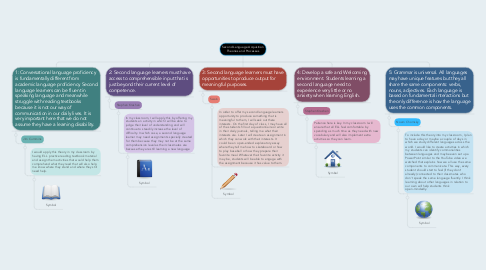
1. 1: Conversational language proficiency is fundamentally different from academic language proficiency. Second language learners can be fluent in speaking language and meanwhile struggle with reading textbooks because it is not our way of communication in our daily lives. It is very important here that we do not assume they have a learning disability.
1.1. Jim Cummins
1.1.1. I would apply this theory in my classroom by having ELL practice reading textbook material and assign them activities that would help them comprehend what they read that will also help me know where they stand and where they still need help.
1.1.1.1. Symbol
2. 3: Second language learners must have opportunities to produce output for meaningful purposes.
2.1. Swain
2.1.1. In order to offer my second language learners opportunity to produce something that is meaningful to them, I will seek out there interests. On the first day of class, I may have all of the students fill out a questionnaire or write in their daily journals, telling me what their interests are. Later I will create an assignment in which they can work with their interests. It could be an open-ended explanatory essay where they tell me how to skateboard or how to play baseball or how they prepare their favorite meal. Whatever their favorite activity it may be, students will be able to engage with the assignment because it has value to them.
2.1.2. Symbol
3. 2: Second language learners must have access to comprehensible input that is just beyond their current level of competence.
3.1. Stephen Krashan
3.1.1. In my classroom, I will apply this by offering my students an activity in which I will be able to judge their level of understanding and will continue to steadily increase the level of difficulty. In which case, a second language learner may need assignments specially created for them because they may not be at the same comprehension level as their classmates are because they are still learning a new language
3.1.1.1. Symbol
4. 4: Develop a safe and Welcoming environment. Students learning a second language need to experience very little or no anxiety when learning English.
4.1. Stephen Krashen
4.1.1. Patience here is key. In my classroom I will ensure that all ELL feel comfortable by spending as much time as they need with new vocabulary and will also implement extra activities so they can learn.
4.1.1.1. Symbol
5. 5: Grammar is universal. All languages may have unique features but they all share the same components: verbs, nouns, adjectives. Each language is based on fundamental interactions but the only difference is how the language uses the common components.
5.1. Noam Chomsky
5.1.1. To include this theory into my classroom, I plan to have a day or maybe a couple of days in which we study different languages across the world. I would like to create activities in which my students can identify commonalities between languages and maybe even set up a PowerPoint similar to the YouTube video we watched that explains how we all use the same components to communicate. This way, every student should start to feel (if they don't already) connected to their classmates who don't speak the same language fluently. I think learning about other languages in relation to our own will help students think open-mindedly.
5.1.1.1. Symbol
